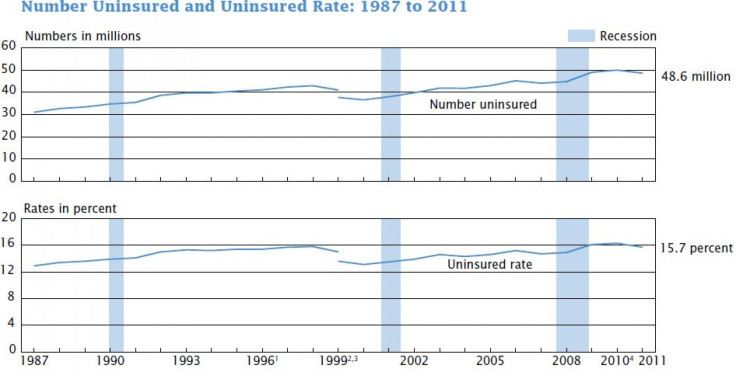Thanks To ObamaCare And Medicaid, More Americans Have Health Insurance

About 1.3 million fewer Americans were uninsured in 2011, according to new data released by the U.S. Census Bureau on Wednesday, an improvement the Obama administration and its supporters have been quick to credit to the passage of the president's healthcare reform law.
The uninsured rate in the U.S. dropped from 16.3 percent in 2010 to 15.7 percent in 2011, marking the first time in three years that the proportion of Americans with health insurance actually went up. Moreover, the Census data shows 2011 to be the first year in a decade where the rate of private insurance remained steady.
"Our main finding is coverage increased between 2010 and 2011," David Johnson, chief of the Census's Chief, Social, Economic, and Housing Statistics Division, told reporters on Wednesday, according to The Washington Post.
Low-Income Americans See Biggest Gain In Coverage
There are two main factors that Census officials say drove down the uninsured rate: The provision of the Affordable Care Act that lets young adults stay on their parents' health plans until age 26, and an increase of Americans using public insurance programs like Medicaid.
In fact, the Census Bureau estimates that as much as 40 percent of the drop in young adults' uninsured rate is due to those individuals receiving extended coverage as a result of the health care law. The U.S. Centers for Disease Control and Prevention came to a similar conclusion earlier this week, when it reported about 1.6 million young adults -- those between the ages of 19 and 25 -- gained health coverage in 2011.
In a White House blog post, the Obama administration said the report demonstrates the policies outlined by the Affordable Care Act are effective.
"Thanks in part to the Affordable Care Act, 1.3 million fewer people were uninsured in 2011," White House deputy press secretary Amy Brundage wrote. "Today's report also shows that thanks in part to the Affordable Care Act, 3.6 million more people were covered by health insurance in 2011."
But the report shows a large drop in uninsured rate can be credited to an expansion of the federal Medicaid program, which provides health coverage for low-income families and individuals with certain disabilities. Government-sponsored health coverage, including Medicare, increased for the fifth consecutive year in 2011, rising from 31.2 percent to 32.2 percent. A chunk of that is likely related to the flood of baby boomers who qualified for Medicare last year.
Rise of Income Inequality Means More Americans May Turn To Medicaid
Although the Census Bureau reports that, after three successive years of increases, the number of people living in poverty edged down from 46.3 million in 2010 to 46.2 million in 2011, the nation's median household income actually decreased by 1.5 percent to $50,054. Meanwhile, income for the top fifth of American earners grew by 1.6 percent during that period, while those in the second, third and fourth tiers -- also known as the middle class -- saw their incomes fall.
So, the good news? Poor Americans now have more access to health care than they used to. The bad? Income inequality is clearly on the rise. And if that trend continues, more Americans will likely begin relying on Medicaid for healthcare access -- a program that House Republicans and Republican presidential candidate Mitt Romney would cut funding for.
If fully implemented, the Affordable Care Act's Medicaid expansion would extend health coverage to 17 million poor and uninsured Americans. That expansion is currently in jeopardy, as several Republican governors have refused to accept federal funding for that purpose.
© Copyright IBTimes 2024. All rights reserved.











